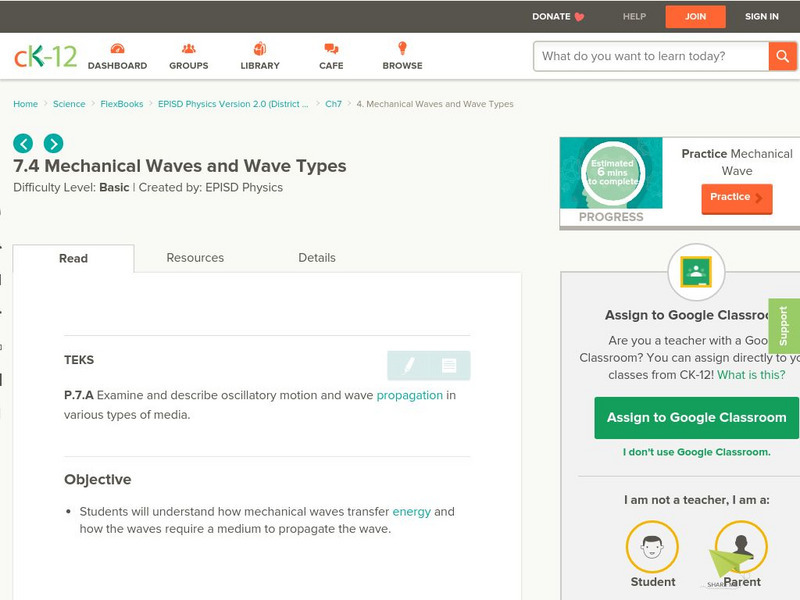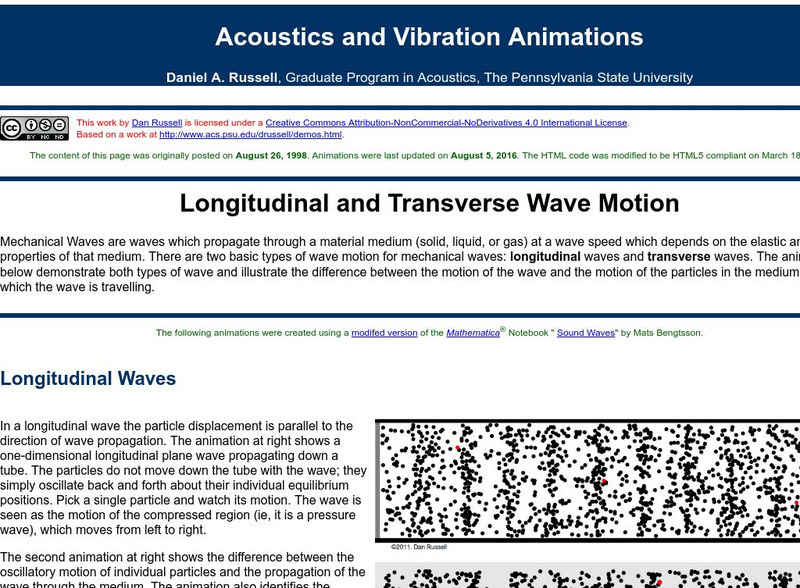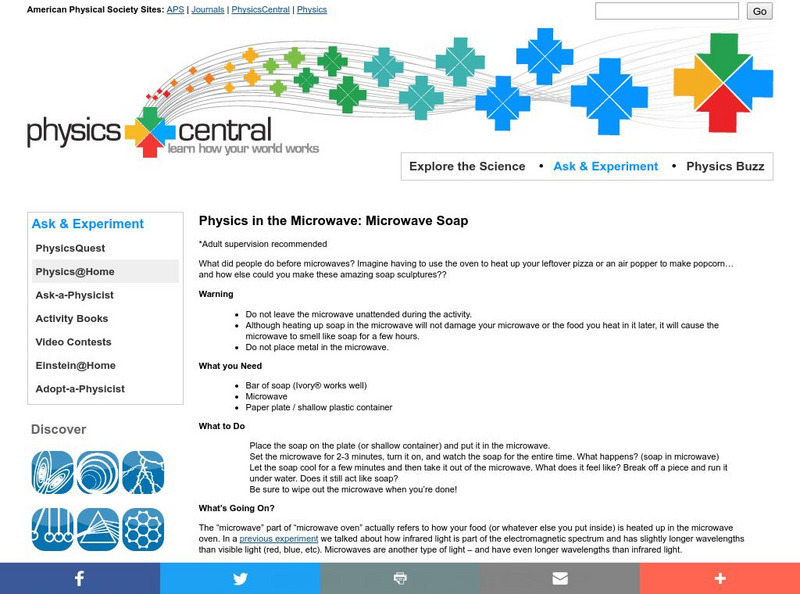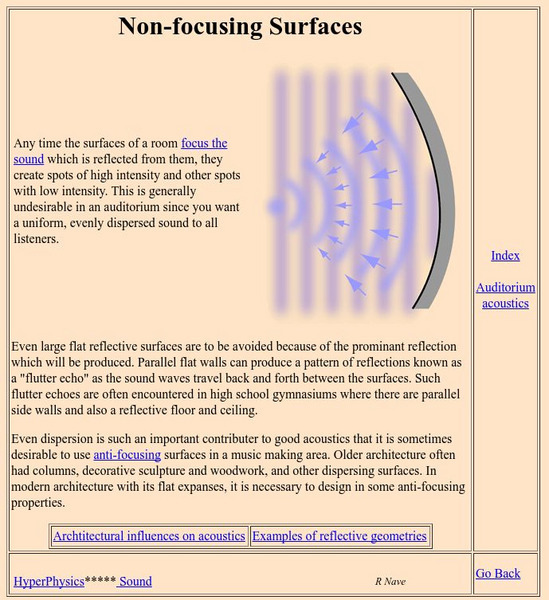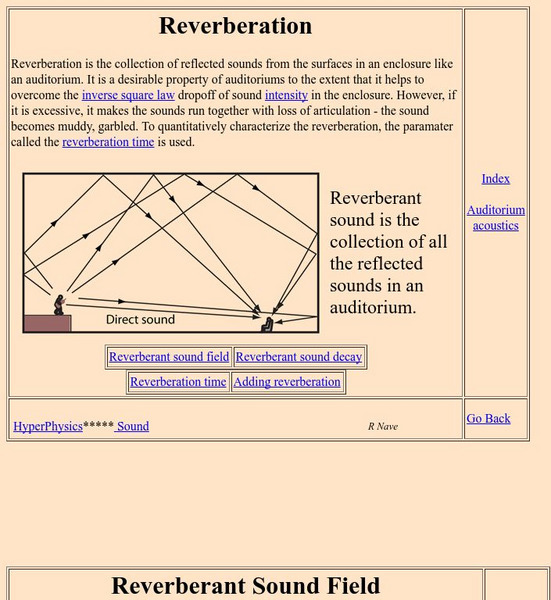PBS
Pbs Learning Media: Frequency
In this interactive activity adapted from the University of Utah's ASPIRE Lab, students will investigate frequency in terms of trampoline jumps, pendulum swings, and electromagnetic waves.
PBS
Pbs Learning Media: What Is a Wave?
This interactive activity adapted from the University of Utah's ASPIRE Lab provides an overview of the characteristics and properties of various types of waves, including light waves, sound waves, and water waves.
CK-12 Foundation
Ck 12: Mechanical Waves and Wave Types
[Free Registration/Login may be required to access all resource tools.] By watching video clips, doing interactives, and reading text, students discover how mechanical waves transfer energy and how the waves require a medium to propagate...
Pennsylvania State University
Wave Animations: Longitudinal and Transverse Waves
This physics tutorial features text and animations explaining the particle motion of a medium through which transverse, longitudinal, or surface waves move.
BBC
Bbc: Gcse Bitesize: General Properties of Waves
Light travels as waves. Waves can be described by their amplitude, wavelength and frequency. The speed of a wave can be calculated from its frequency and wavelength.
PBS
Pbs Learning Media: Mechanical Waves: Interactive Lesson
Learn about mechanical waves, which transfers energy from one place to another through liquids, gases and solids, with this interactive lesson.
Concord Consortium
Concord Consortium: Exploring Earth's Seismicity
This sequence is an introduction to plate tectonics using evidence from topographical maps, earthquake location and depth, and volcano location using the Seismic Explorer model to investigate patterns of earthquake data and to infer the...
PBS
Pbs: Physics Girl
Explore the physical world with this series that uses everyday experiments to demonstrate scientific ideas on this site.
National Women’s History Museum
National Women's History Museum: The Waves of World War Ii
Discover more about the women of the Naval Reserve during World War II.
Physics Central
Physics Central: Physics in the Microwave: Microwave Soap
An experiment involving a bar of soap and a microwave through which students explore how microwaves affect molecules.
Curated OER
Education in Physics and Mathematics: Wave Parts
A physics site, it describes aspects of waves, like the sine wave The explaination is good and it illustrates the connection between mathematics and physics.
Georgia State University
Georgia State University: Hyper Physics: Wave Motion
Two wave graphs depicting a sine wave and relating the various characteristics (wavelength, amplitude, frequency, and period) of a wave to each other. The site includes an interactive JavaScript form in which the visitor enters one...
Georgia State University
Georgia State University: Hyper Physics: Traveling Wave Relationship
Online physics text that illustrates and explains the various characteristics of waves such as amplitude, period, frequency, wavelength, and speed. Includes interactive exercises.
Georgia State University
Georgia State University: Hyper Physics: Musical Instruments
Homepage for a hypertext about the different families of musical instruments. From this page, users can retrieve information on a the acoustics of a variety of specific instruments: stringed instruments, woodwind instruments, brass...
Georgia State University
Georgia State University: Hyper Physics: Architecture for Acoustics
A physics tutorial on designing an auditorium and solving the problem of sound reflection. Illustrated.
Georgia State University
Georgia State University: Hyper Physics: Non Focusing Surfaces
This hypertext physics course tutorial on nonfocusing surfaces relates various design principles to good auditorium design. Illustrated.
Georgia State University
Georgia State University: Hyper Physics: The Place Theory
An indexing page for an elaborate and in-depth hyper-textbook on various physics topics. This page indexes several others which pertain to human ability to perceive sound and recognize pitch. Introduces and explains Place Theory.
Georgia State University
Georgia State University: Hyper Physics: Sound Propagation
This page and the many pages which are indexed to focus on the behaviors of sound which characterize it as a wave. Reflection, refraction, interference, diffraction and more are clearly illustrated and explained.
Georgia State University
Georgia State University: Hyper Physics: Water Tube Resonance Experiment
Online physics lab experiment in which students use resonating waves inside of a closed-end air column to determine the speed of sound. The form allows students to check their answers and receive immediate feedback.
Georgia State University
Georgia State University: Hyper Physics: Reverberation
A tutorial from a hypertext physics course book that discusses reverberation. Illustrated.
Georgia State University
Georgia State University: Hyper Physics: Sound Level Measurement
Home page for a hypertext physics course. Users can access subjects ranging from the sound wave parameters that effect hearing and communication to OSHA worplace standards.
Georgia State University
Georgia State University: Hyper Physics: Refraction of Sound
A discussion of refraction and its application to sound waves. Using analogies, graphics and real-life applications, this page and those that accompany it explain why and when sound waves bend.
Georgia State University
Georgia State University: Hyper Physics: Resonance
This hypertext physics course surveys sound resonance in musical instruments. Illustrated.
Georgia State University
Georgia State University: Hyper Physics: Sound and Hearing
Home page for a hypertext course on physics. Accesses a range of topics from hearing to sound measurement to sound propoation to musical instruments.

